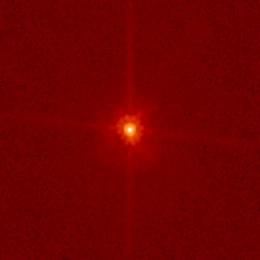
Makemake, minor-planet designation 136472 Makemake, is a dwarf planet and perhaps the largest Kuiper belt object (KBO) in the classical population, with a diameter that is about 2/3 the size of Pluto. Makemake has no known satellites, which makes it unique among the largest KBOs and means that its mass can only be estimated. Its extremely low average temperature, about 30 K (−243.2 °C), means its surface is covered with methane, ethane, and possibly nitrogen ices.
Discovery[]
Makemake was discovered on March 31, 2005, by a team at the Palomar Observatory, led by Michael Brown, and was announced to the public on July 29, 2005. The team had planned to delay announcing their discoveries of the bright objects Makemake and Eris until further observations and calculations were complete, but announced them both on July 29 when the discovery of another large object they had been tracking, Haumea, was controversially announced on July 27 by a different team in Spain. Despite its relative brightness (it is about a fifth as bright as Pluto), Makemake was not discovered until well after many much fainter Kuiper belt objects. Most searches for minor planets are conducted relatively close to the ecliptic (the region of the sky that the Sun, Moon and planets appear to lie in, as seen from Earth), due to the greater likelihood of finding objects there. It probably escaped detection during the earlier surveys due to its relatively high orbital inclination, and the fact that it was at its farthest distance from the ecliptic at the time of its discovery, in the northern constellation of Coma Berenices. Besides Pluto, Makemake is the only other dwarf planet that was bright enough for Clyde Tombaugh to have possibly detected during his search for trans-Neptunian planets around 1930. At the time of Tombaugh's survey, Makemake was only a few degrees from the ecliptic, near the border of Taurus and Auriga, at an apparent magnitude of 16.0. This position, however, was also very near the Milky Way, and Makemake would have been almost impossible to find against the dense background of stars. Tombaugh continued searching for some years after the discovery of Pluto, but he failed to find Makemake or any other trans-Neptunian objects.
Name[]
The provisional designation 2005 FY9 was given to Makemake when the discovery was made public. Before that, the discovery team used the codename "Easterbunny" for the object, because of its discovery shortly after Easter. In July 2008, in accordance with IAU rules for classical Kuiper belt objects, 2005 FY9 was given the name of a creator deity. The name of Makemake, the creator of humanity and god of fertility in the mythos of the Rapanui, the native people of Easter Island, was chosen in part to preserve the object's connection with Easter.
Initially known as 2005 FY9, Makemake was later given the minor-planet number 136472, it was discovered on March 31, 2005, by a team led by Michael Brown, and announced on July 29, 2005. Makemake was recognized as a dwarf planet by the International Astronomical Union (IAU) in July 2008. Its name derives from Makemake in the mythology of the Rapanui people of Easter Island.